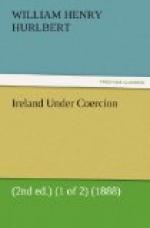These labourers work for the small farmers from April to November; and between the autumn and the spring their wives and daughters knit, and by the Baron’s Court machinery are enabled to dispose of, nearly twenty thousand pairs of woollen socks. The yarns are brought from Edinburgh to the store-house at Baron’s Court. Thither every Wednesday come the knitters. Mrs. Dixon weighs the hanks of yarn, and gives them out.
On the following Wednesday the knitters reappear, each with her bale of stockings or socks. These are again weighed, and the knitters receive their pay according to the weight, quality, and size of the goods. In some families there are four, five, or six knitters. All these people, with four or five exceptions, are small cottars living on wretched little mountain farms, not on the Duke of Abercorn’s property; and but for this industry they would be absolutely without employment all the winter through.
Some of them come from a distance of twelve or fourteen miles, and but for this resource would literally starve. They are nearly all of them Catholics, and the Protestants here being Unionists, they are probably Nationalists. About three hundred knitters in all are employed. In the year 1886-87 the orders given for Baron’s Court work enabled Mrs. Dixon to pay out regularly about five pounds a week, not including casual private orders. For the current year the orders have been much larger, and the expenditure proportionally greater. Mrs. Dixon’s storehouse was full of goods to-day. The long knickerbocker stockings which she showed us were remarkably good, some in “cross-gartered” patterns, handsomer, I thought, than similar goods in the Scottish Highlands—and all of them staunch and well-proportioned.
For socks such as are supplied to the volunteers and the troops the War Office pays 8-3/4d. a pair.
It was pleasant to learn from Mrs. Dixon that these people thoroughly appreciate the spirit which prompted and still directs this enterprise. Last spring when the Duchess was thought for a time to be hopelessly ill, a young girl came down to Baron’s Court weeping bitterly. On her arm was a basket, in which were two young chanticleers crowing lustily. The poor girl said these were all she had, and she had brought them “to make soup for the Duchess, for she heard that was what the great people lived on, and it might save her life.”
This afternoon I went over by the railway to Derry with Lord Ernest to attend a meeting there. The “Maiden City” stands picturesquely on the Foyle, and has a fine, though not large, cathedral of St. Colomb, restored only last year, of which it may be noted that the work never was undertaken while the Protestant Church of Ireland was established by law, and has been successfully carried out since the disendowment of that Church. The streets were white with snow, but the meeting in the old Town Hall was largely attended. It was, in fact, a sort




